|
|
| Skip to penguin, collared lemming, Arctic fox, snowy owl. |
| Description:
The polar bear has many unique adaptations for dealing with the cold and snow of the
Arctic. The polar bear is covered in thick fur that
keeps water away from his/her skin. It
also has large, furry feet which act as snow-shoes.
It has an excellent sense of smell(they can smell a dead seal from 20 miles away), and they can bound across the snow at high speed. Polar bears are also great swimmers and they have been seen swimming up to 50 miles from the nearest land. |
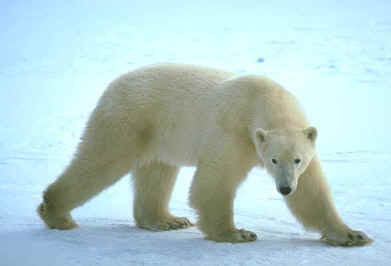 |
|
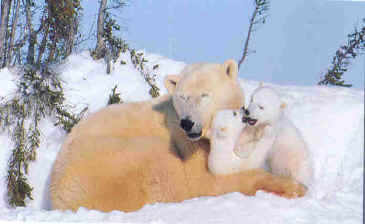 |
Diet: Eats mostly ringed and bearded seals. They will occasionally eat other mammals, eggs, vegetation and beach-cast carrion. Polar bears don't drink water. They get all the liquids that they need from the animals that they eat. |
|
Home: The Polar Bear is the largest bear on Earth, and lives in the Arctic.
|
|
Penguins
| Description: Penguins are only found down near the south pole. The world's largest penguin, the Emperor, lives on the Antarctic mainland. Adult Emperor penguins are typically 1.2 metres tall. Juveniles are slightly shorter, only about 90cm to 1m. Emperors live on the snow and ice, close to the sea, all year long. |
| Food: squid and
fish
Particularity: after the female penguin lays an egg, the males keeps it warm between his belly and his feet for about 60 days. During this period they don't eat and thus loose half their weight (20kg). In order to prevent themselves getting cold, the males gather together in 'turtles' which are a large group of penguins huddled together. After August, both partners take care of the only chick, recognised by its voice, taking turns to get food at sea every 2 weeks. |
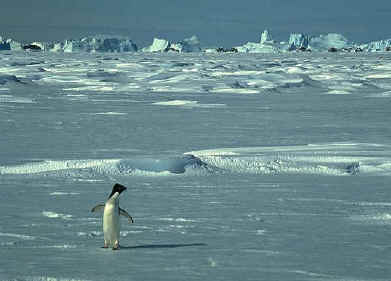 Lone penguin roams to snow and ice of the
Antarctic. Lone penguin roams to snow and ice of the
Antarctic. |

|
Diving:
Penguins are really fast swimmers, up to 60 km/h. The deepest dives recorded lasted 16
minutes at 534m. The average dive is 5 to 6 minutes around 100m. Depth and duration of a
dive vary from place to
place and availability of surface food.
|
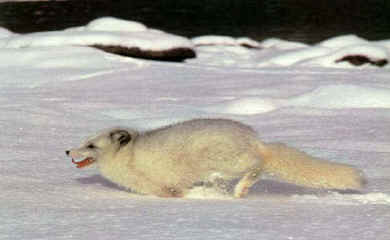 |
Description: The arctic fox lives farther north than any other fox. They are well adapted for the cold harsh weather of the Arctic. They have a warm fur coat which turns white for the winter months. Also, because they are white they can camouflage themselves in the snow.
Diet: The arctic fox can hunt lemming that they can't see beneath the snow, but if the arctic fox can't kill enough to eat, it will settle for leftovers from other animals.
<= Young Arctic Fox cub in the summer. Their dark coat turns white for the winter. |
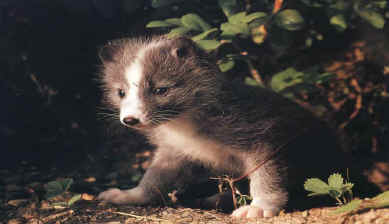 |
| Description: The collared lemming is one of the most interesting Arctic animals because of how it has adapted to the cold Arctic temperatures. It is a small rodent that burrows under the snow or ground making many tunnels and nesting areas. The collared lemming has large claws on the third and fourth 'fingers' of its front feet that it uses for burrowing. | ||
 Collard lemming in the winter |
Home: Only in the Arctic tundra. During the summer collared lemmings live on the high, dry areas of the tundra. They burrow under the rocks. During the winter the collared lemmings move to lower meadows where there is more snow. Diet: Summer Tender shoots of grasses, in the winter they eat bark and twigs off the willow tree. |
 Collard lemming in the summer. |
Many birds come to the Arctic in the summer to live and breed but not all of them live here year round, snowy owls are one of the few Arctic birds that live here year round. Snowy owls live on the tundra .
| Description:
They are called
snowy owls because their colouring is almost
pure white when
they are full grown. The feet of snowy owls are covered with feathers and have extra thick
pads. Vision: Snowy owls have incredible vision. They can see from high up in the sky and swoop down silently to capture their prey. Like all owls they have good night vision. |
 |
Diet:
They stay
in the Arctic during the winter
unless their food sources are scarce. If they leave the arctic in the winter they
overwinter in northern Greenland, the Canadian islands, or North America.
|